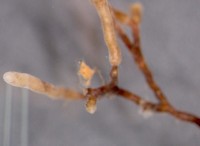Fungi, fungicides and fertiliser

Research that may help nursery growers produce faster growing, more robust radiata pine seedlings has been recently published by Christchurch-based Scion microbiologist, Simeon Smaill and Katrin Walbert from the Rotorua office.
Mycorrhizae are critical to the establishment and growth of radiata pine seedlings. They are a class of fungi living in close association with the roots of most plant species and greatly increase root area, thereby improving water and nutrient uptake. Scientists guess there may be as many as 25,000 different species.
Simeon and Katrin set out to discover what effect variations in fertiliser and fungicide applications (common nursery practices) have on the mycorrhizal associations with radiata pine seedlings. They were particularly interested to know if fertiliser or fungicides had an effect on the composition of these mycorrhizal species in nine-month-old radiata pine seedlings.
Increased fertiliser and fungicide application rates substantially reduced the relative abundance of Rhizopogon rubescens mycorrhizae on the roots and increased the presence of a number of other species. R. rubescens is the species most closely linked with nutrient uptake in these seedlings, so it appeared that both fertiliser and fungicide use has a detrimental effect on seedling nutrient uptake.
The authors of the report were quick to caution that nursery managers should not abandon the use of fertiliser or fungicide, because there are valid growth target and disease mitigation reasons not to. However, overuse of these products may leave seedlings with a reduced ability to uptake nutrients later in life.
Simeon and Katrin’s research appears in Applied Soil Ecology 65 (2013) 60-64.
